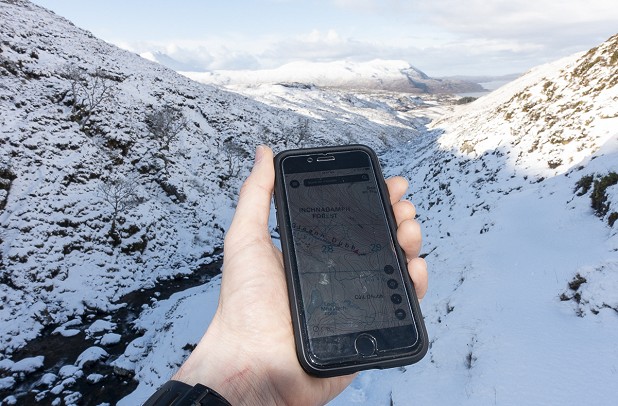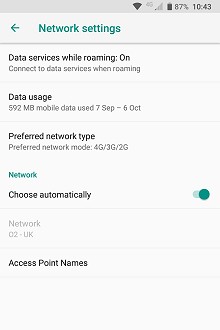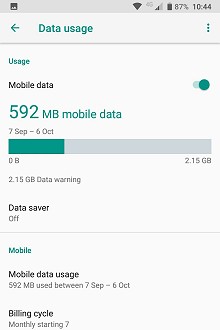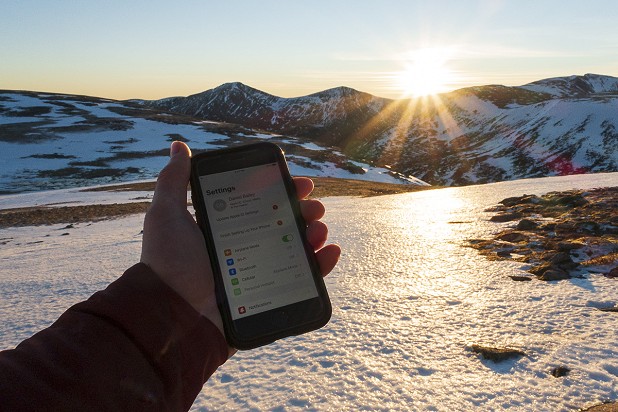How to Prolong Your Phone's Battery Life Outdoors
If you often go walking or climbing in the hills, or enjoy overnight trips with a tent or bivvy, you'll be familiar with the outdoor equivalent of "range anxiety" – the fear that your phone battery will run out before you reach journey's end. Winter is a particular concern, thanks to the effect of cold on batteries. However, with a little knowledge and some minor tweaks it is possible to get that battery to last at least several days, if not a whole week – depending on the choices you make.
If you adopt all the measures covered below you should be able to extend the time between charges from hours to days. My own smartphone, for example, recently went five days without charge, and the battery was still at 21% when we eventually found a campsite with electricity.
Some provisos. Ultimately the duration of the charge in your battery will depend on how much you use your phone. Even if you take other measures, should you continue to stream 4k movies while messaging your mates and constantly checking your GPS position, then your battery is going to run down pretty quickly.
Another caveat: the world has many different phone manufacturers, software versions, and brand customizations. It would be impossible to accurately describe the details for each. This article looks at individual actions that should be possible on all phones – although some may require a bit of investigation by you to find the location of the exact setting.
Remember the era before smart phones when your early mobile could go a whole week between charges? Just because you can get 4G at the top of Ben Nevis, doesn't mean that you have to use it
Consider the cold
Bear in mind that your phone and its battery will perform very differently in cold conditions, and in high wind or very low temperatures it may struggle to hold a charge for long. In colder weather - and in the hills this can really mean any time of year (but of course most especially in winter) it's worth keeping your phone close to your body - an inside pocket works best. When camping, make sure the phone is in your sleeping bag, not freezing in a tent pocket. If you are using your phone in harsh cold environments, then any extended battery life you might glean with the following measures is still likely to be highly compromised. Limit the amount that you get it out of your pocket to use!
Why not just switch off?
A common misconception is that switching your phone off is the best way to save your battery. Sure, if you switch your phone off and don't switch it on again for a week then you will have saved battery, but then emergencies aside, why bother taking the phone with you? As the operating system powers down the phone, and then powers it up again when you switch it back on, it will use up a proportion of the remaining battery charge. For example my previous phone used to lose as much as 10% if I restarted it, although thankfully my latest model loses only 2%.

Flight mode
To avoid shutting down your phone and then having to power it on again, instead just switch your phone into airplane mode. Airplane mode will disconnect all the data and voice channels, turn off the GPS, turn off the WiFi, but still allow you to use your phone in other ways. Better still, most phones will allow you to turn back on the GPS while in flight mode, allowing you to use your phone for navigation but without requiring those power hungry data channels. Check your navigation apps to see if any of them can work offline.
A phone in flight-mode uses so little power that it may lose only 1% of the battery or less over a 12 hour period. In theory, it could run for several weeks and not require a recharge.
You can even play it smart and selectively enable or disable airplane mode to retain functionality but maximize your battery: Flight mode on at night when you are asleep, flight mode off when you are walking and may want to make calls or check your navigation app.
There is another benefit from using flight mode. It can be enabled or disabled without requiring the user to unlock the screen. Should you find yourself in need of assistance you or someone else can still use your phone to make that emergency call.
If you are in a network blind spot where there is no signal (still an issue in some of the remote summits or deep valleys of the UK) then switch on the flight mode to save your phone the effort of scanning for a mobile mast that isn't there.
You may also want to do this if the signal icon is showing a very poor signal. While in your pocket your phone is actually rather busy. It regularly sends out "I am here" signals and then listens for any base stations that reply with "yes, I can hear you". In areas of low signal the phone has to "shout louder" as it performs these regular checks and these stronger transmissions can drain the battery more.
Tweak your data connection
The big user of battery power is the data connection. Remember the era before smart phones when your early mobile could go a whole week between charges? Just because you can get 4G at the top of Ben Nevis, doesn't mean that you have to use it.
Before smart phones, 3G, 4G and now 5G, GSM was the standard (now referred to as 2G). 2G didn't support data (not strictly true, see below) but it did support voice calls and text messages. 2G coverage in the UK is still far more extensive than either 3G, 4G or 5G, meaning it is still possible to phone or text people from remote places. If only you could force your smart phone to use 2G…

Well you can. This is where your phone settings may differ a little from my explanation here, but a bit of searching on the internet should allow you to find the right settings.
There are two things you need to change. First, a setting which specifies the type of network to use. On an android phone this setting can be found under "Settings->Network->Connection Type", and will typically list "5G, 4G, 3G or 2G" or other network standards, and will default to the data package you have purchased. Switch it to "2G" and you get an immediate quick win with respect to battery life.
Don't forget the original setting as you will want to switch it back when you want your phone to return to its usual mode of operation.
Another useful tip is that it is possible to download apps that provide a short cut for this setting, making the process a lot easier.
To be fully effective though, you need to take one more step.

By switching to 2G you have effectively turned back time on your phone to before the era of 3G – and can continue to use your phone just as you would that old beloved Nokia handset you used to own – making phone calls and sending text messages but enjoying a battery life measured in days rather than hours.

Other Wins
You can do more still, should you want to:
- The next biggest drain on battery life is the camera. Of course, if you aren't using the camera much then it won't be using much power, but if you do like to take pictures or shoot film, but want to preserve your phone's charge, then it may be worth carrying a separate camera.
- The large touchscreen of the modern smart phone is also power hungry. You can do two things to reduce the amount of power it requires - turn down the brightness and also reduce the timeout before the OS switches the screen off. There are settings that allow you to configure these.
- The next action you can take is to switch on power save, sometimes called battery saver. This option will usually become disabled again next time you charge your phone so you'll need to remember to enable it again after a charge. Your phone may allow you to switch on this mode permanently – check the details of your specific phone.
- Consider disabling the vibrate alert for calls and text messages. It is a considerable drain on your battery when you are receiving lots of messages or calls.
Finessing that power usage
Three other features that haven't yet been discussed are GPS, Bluetooth and WiFi.
GPS will definitely drain your battery quickly. If you are out for a hike and know where you are going and don't need GPS you can explicitly disable it from the system settings. Often described in the settings as "Location", you can always manually turn it back on again should you wish to use it, for instance when navigating using an app.
Bluetooth has improved much in recent years but it has a reputation for being power hungry. On Android phones it can easily be disabled from the pull down menu. iPhones have options in the settings that disable Bluetooth.
WiFi scanning will use some power but is considerably more energy efficient than GPS or data usage. All the same you are unlikely to be using it as you hike across the hills or spend the day at a crag, so it can be disabled in the settings until you want to use it.
The most important lesson is that you can enable just those features you need to help extend the charge in your battery. Keep GPS if you have an off-line mapping app that you like to use, but disable everything else mentioned above – and only refer to that app when you need to - and you can still gain yourself a significant extension on the battery life without compromising the usefulness of taking your smart phone.
Other useful things to know
It was mentioned earlier that the battery uses more power in areas where there is low signal. Just because your network doesn't have a signal doesn't mean that strong signal from another provider isn't available. If your phone is showing the legend "Emergency Calls Only" that means that there is a signal, it is just on another network. By convention 999 calls are permitted regardless of provider (the European equivalent of 112 also works in the UK as it is just an alias for 999).
For potential emergency assistance it's worth registering for police texts rather than calls. Though it's primarily for low signal areas, if you are on very low battery, sending a text will use a lot less power than making a call. To register your phone for emergencySMS see here.
You might not be aware that your phone may be able to send and receive text messages even if it's showing no signal. SMS messages are sent via a part of the network infrastructure called the Non-Access Stratum, and the screen doesn't show the signal strength for this part of the network. There are no guarantees, as you may well be in a network black spot for both types of signal, but if you find yourself in an emergency situation with no signal for a voice call then you may as well try to send a text – it could be a life saver.
Battery top-ups
Portable power packs are small and affordable these days, so it makes sense to carry an external battery from which to recharge your phone (don't forget to pack the USB cable!). This is a particularly sensible measure if you're out in winter, or on an extended overnight trip.
Thanks and Credits
Thanks to my friend Peter Thurston for proof reading and tip suggestions, and to the team at UKHillwalking for their positive feedback and contributions.

